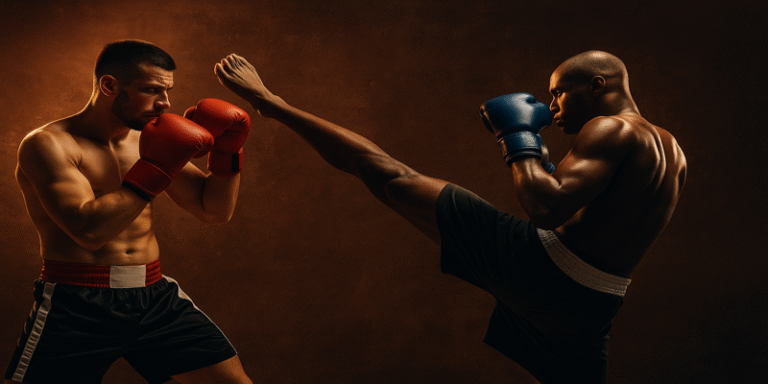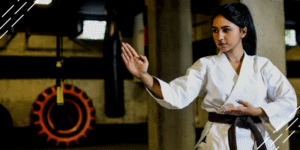Combat sports vary widely in technique, rule-sets, physical demands, and objectives. This article explores four prominent disciplines—boxing, heavyweight boxing, kickboxing, and wrestling—highlighting their histories, technical nuances, physiological demands, and competitive structures.
1.0 Boxing
1.1 Overview & Styles
Boxing is defined by the exclusive use of gloved fists to strike legal targets—torso and head—under strict rules (Tshibangu, 2023). Four classic styles exist:
- Out-fighter (boxer) – maintains distance, uses jab and footwork (Wikipedia, 2025a).
- Swarmer (in-fighter) – pressures inside with hooks and uppercuts (Wikipedia, 2025a).
- Slugger (brawler) – relies on powerful single blows (Wikipedia, 2025a).
- Boxer-puncher – blends speed and power (Wikipedia, 2025a).
Defensive techniques, including slipping, bobbing, weaving, and shoulder-roll (commonly known as the “crab defence”), are fundamental (Wikipedia, 2025a).
1.2 Physiology & Performance
Elite boxers exhibit high aerobic and anaerobic capacity. Peak oxygen uptake (VO₂ max) is central to performance (Tshibangu, 2023). Kinanthropometric and ergometric data from England internationals show punch forces reaching 3,427 ± 811 N, with rear-hand hooks exceeding 4,405 ± 2,318 N (Tshibangu, 2020). Strength training has been shown to enhance both upper- and lower-limb power and rate of force development in amateur boxers (Castro et al., 2024).
1.3 Weight Management
Making weight is intrinsic to boxing. A 12-week study on a professional boxer in the super-featherweight division (59 kg) recorded an average weekly weight loss of 0.9 ± 0.4 kg, using a 40% carbohydrate, 38% protein, and 22% fat diet (Matthews and Nicholas, 2010). However, rapid weight loss strategies exceeding 5% of body weight can impair mood, hormonal balance, and overall performance (Yen, Su and Wang, 2024).
2.0 Heavyweight Boxing
2.1 Definition
Heavyweight boxing refers to athletes competing in weight classes over 90.7 kg (200 lb) (Tshibangu, 2023). These fighters are characterised by greater muscle mass and knockout power.
2.2 Anthropometric Traits
Recent research on heavyweight professionals has identified anthropometric factors—such as height, reach, and lean body mass—as potential indicators of long-term success (Curtis et al., 2024).
2.3 Style & Physiology
Heavyweight boxers typically move slower but strike with greater force. Punch force and effective mass correlate strongly with weight class (Tshibangu, 2020). Due to their size, they often face reduced pressure around weight cuts but must manage higher metabolic loads.
3.0 Kickboxing
3.1 Overview & History
Kickboxing combines punches and kicks in full-contact competition, often held in a boxing ring using gloves (Wikipedia, 2025b). It evolved during the 20th century from a hybrid of karate and Muay Thai and has since expanded into various international rule-sets.
3.2 Rulesets
Common styles include:
- American – punches and above-waist kicks only.
- Oriental/K-1 – includes knees and low kicks.
- Dutch and Muay Thai – allow elbows, clinch work, and more diverse striking techniques (Wikipedia, 2025b).
3.3 Physiology & Attributes
Kickboxers require a mix of strength, speed, and endurance. Their anthropometric and psychophysiological profiles indicate high levels of explosive power, flexibility, and aerobic capacity (Slimani et al., 2017). A systematic review also suggests combat sports like kickboxing benefit mental health and self-regulation (Yen, Su and Wang, 2024).
4.0 Wrestling
4.1 Overview & Disciplines
Wrestling is a grappling-based combat sport focused on takedowns, pins, and positional control (Wikipedia, 2025c). Styles include freestyle and Greco-Roman (upper-body only), alongside folk variations such as Sambo.
4.2 Growth & MMA Impact
Wrestling has become foundational to mixed martial arts (MMA), with many champions (e.g., Khabib Nurmagomedov, Randy Couture) having wrestling backgrounds (Wikipedia, 2025c).
4.3 Physiology & Training
Wrestlers develop significant strength, anaerobic endurance, and technical skill. Although fewer journal articles detail wrestling physiology than striking sports, it is widely accepted that the sport cultivates superior musculoskeletal adaptation (Reilly et al., in Tshibangu, 2023).
5.0 Comparative Summary
| Feature | Boxing | Heavyweight Boxing | Kickboxing | Wrestling |
| Strikes | Punches only | Punches only | Punches + kicks (± knees) | None (grappling only) |
| Targets | Head & torso | Head & torso | Head, body, legs | Body, limbs (holds, pins) |
| Grappling | Limited clinch | Limited clinch | Limited (K-1 allows clinch) | Central element |
| Rounds/Match | 3–12 × 3 min | 3–12 × 3 min | Varies (3–5 rounds) | Typically 2–3 × 2–3 min |
| Physical Focus | Speed, endurance, power | Power, durability | Flexibility, strength, endurance | Strength, leverage, control |
| Technical Depth | Footwork and defence | Similar, more force-focused | Diverse striking techniques | Technical grappling |
6.0 Safety & Health Considerations
Boxing and kickboxing are associated with head injury and concussion risks, though protective gear and structured competition seasons mitigate these (Tshibangu, 2023). Rapid weight loss strategies in all combat sports are linked to mood disorders, reduced performance, and hormonal imbalance (Yen, Su and Wang, 2024).
Wrestling is physically intense and poses joint stress and injury risks. However, it builds high musculoskeletal resilience (Reilly et al., in Tshibangu, 2023).
7.0 Applications & Recommendations
Self-defence: Wrestling excels in ground control; boxing and kickboxing provide effective striking.
Fitness: Boxing and kickboxing offer superior cardio; wrestling builds strength and agility.
Competition: Choice should depend on personal goals, body type, and preference for striking or grappling.
Boxing, heavyweight boxing, kickboxing, and wrestling represent diverse combat traditions with unique strategic and physical demands. Each offers different benefits for fitness, self-defence, competition, and personal development. Understanding their distinctions allows athletes and enthusiasts to select a path aligned with their goals and capabilities.
References
Castro, A.S., Costa, T.L., Santos, V.B. and Souza, D.S., 2024. Strength training enhances lower and upper limb power and rate of force development in amateur boxers. Applied Sciences, 14(21), p.9706. Available at: https://www.mdpi.com/2076-3417/14/21/9706 [Accessed 19 Jul. 2025].
Curtis, R.M., Hsieh, M.H., Krzysik, S.L. and Cavazos, J.T., 2024. Anthropometric predictors of long-term performance in elite heavyweight boxing. International Journal of Sports Science & Coaching, [online] Available at: https://journals.sagepub.com/doi/abs/10.1177/17479541241311094 [Accessed 19 Jul. 2025].
Matthews, J.J. and Nicholas, C., 2010. Making weight in boxing: a case study of a professional boxer. Journal of Sports Science and Medicine, 9, pp.199–204. Available at: https://pubmed.ncbi.nlm.nih.gov/20190355/ [Accessed 19 Jul. 2025].
Slimani, M., Miarka, B., Bragazzi, N.L. and Chamari, K., 2017. Anthropometric, physiological and psychophysiological attributes of male and female combat sport athletes: an update. Journal of Strength and Conditioning Research, [online] Available at: https://www.ncbi.nlm.nih.gov/pmc/articles/PMC5424459/ [Accessed 19 Jul. 2025].
Tshibangu, A., 2020. Kinanthropometric and ergometric profile of elite amateur boxers in England: implications for performance. Open Journal of Molecular and Integrative Physiology, 10, pp.9–22. Available at: https://www.scirp.org/journal/paperinformation?paperid=97871 [Accessed 19 Jul. 2025].
Tshibangu, A., 2023. Boxing practitioners physiology review: systemic responses and adaptations. Open Journal of Molecular and Integrative Physiology, 13, pp.1–67. Available at: https://www.scirp.org/journal/paperinformation?paperid=124106 [Accessed 19 Jul. 2025].
Wikipedia, 2025a. Boxing styles and technique. [online] Available at: https://en.wikipedia.org/wiki/Boxing_styles_and_technique [Accessed 19 Jul. 2025].
Wikipedia, 2025b. Kickboxing. [online] Available at: https://en.wikipedia.org/wiki/Kickboxing [Accessed 19 Jul. 2025].
Wikipedia, 2025c. Wrestling. [online] Available at: https://en.wikipedia.org/wiki/Wrestling [Accessed 19 Jul. 2025].
Yen, C.H., Su, H.J. and Wang, J.J., 2024. Martial arts, combat sports and mental health in adults: a systematic review. Journal of Science and Medicine in Sport, [online] Available at: https://www.sciencedirect.com/science/article/pii/S1469029223001802 [Accessed 19 Jul. 2025].









